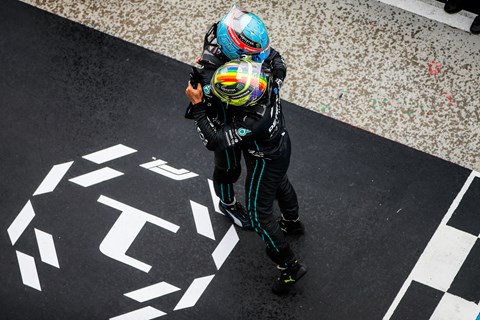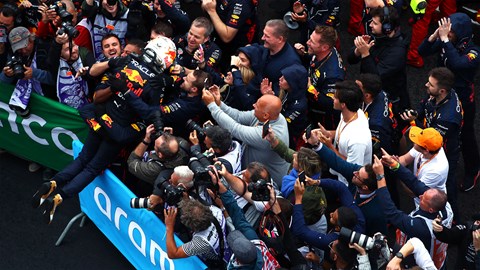► A look at the 2022 Hungarian GP
► Ferrari falters while Red Bull maximises points
► Mercedes gets its first 1-2 on pure pace
The Hungarian GP always seems to deliver a classic race – despite how tricky it is to pass at the Hungaroring – and this year was no different. A damp qualifying session produced a relatively mixed grid, with George Russell’s Mercedes beating both Ferraris to pole. Sunday was equally chaotic, with the ongoing threat of rain and some very interesting strategy calls resulting in a race that was finely balanced on tyre management and robust overtakes.
So what were the key takeaways for the 2022 Hungarian GP, keep reading to find out.
1. Ferrari fumble
If Verstappen wins this year’s championship, it’ll surely be seen as the one gifted to him by Maranello. The Scuderia had the fastest car for the first few races this year, but reliability issues, poor strategies and driver errors meant they failed to capitalize on their pace advantage. Now Ferrari finds itself with a car that isn’t necessarily fastest, but with all the same problems as before – and nowhere was that more obvious than Hungary. After a qualifying session that saw both drivers fail to string together a perfect lap, the race itself was even more shambolic.
It’s seems as though conditions meant that Ferrari never truly had the pace to win, but some decisions – such as putting Leclerc on hard tyres for one stint – simply didn’t make sense, especially when teams could see it was the wrong tyre to be on.
The result? Verstappen’s lead to Leclerc has now increased to 80 points (over three race wins) and Leclerc will essentially have to finish in front of the Red Bull driver every race to even be in with a chance of winning the championship. Throw in the car’s constant reliability issues and Binotto’s reluctance to concentrate on Leclerc, and it’s looking like another Red Bull championship, albeit a deserved one.
2. Mercedes makes a step

If Ferrari are failing in every area but pace, it’s fair to say Mercedes are doing the exact opposite. Aside from a DRS failure on Saturday that cost Hamilton a shot at pole, Mercedes extracted as much as they could from this weekend and the W13, gaining their first pole, a fastest lap, and their first double podium on pace. Mercedes still hasn’t won a race this year, but if it does, Hungary will be seen as the race in which it started looking possible.
What’s more, Mercedes appears to be the only team where both drivers are getting a similar level of performance from the car, with Hamilton usually eeking out an advantage on race day. After a slow start Sainz now appears to be significantly faster than Leclerc, while the Red Bull drivers are at least half a second apart on pace right now.
The only catch? Brackley’s pit stops are still routinely longer than the other top teams – something which effected the team last year and isn’t helping this year either.
3. Alpine loses Alonso
Hungary 2021 was a incredible race for the Alpine team, but 12 months on saw less impressive finish in 8th and 9th. However, robust defending from Ocon and some interesting Alonso moves meant that the Alpine team did at least provide some entertainment to fans.
But the biggest news? Just a day later, Alonso announced a move to Aston Martin. Taking the recently vacated seat of Sebastien Vettel, Alonso will now partner-up with Lance Stroll and leave an Alpine seat free – possibly for Oscar Piastri.
4. Red Bull cleans up

Look at the first half of this year, and it’s clear to see which teams are used to fighting for championships. Disparity and reliability aside, the Red Bull pitwall has extracted everything possible out of weekends, with the sharpest strategies and pit stops by far. Logistically Red Bull is the team to beat. Throw in the flexi-floor rocket ship the team have created, along with Ferrari’s puzzling decision-making, and it’s no surprise Max enjoys the lead he does.
5. Life without Flexi-floors
F1 now enters a summer break, with the sport returning to Spa for the Belgian GP at the end of August. Alongside some possible upgrades, it’s also the first time we’ll see the effects of a new technical directive banning flexible floors.
Simply put, flexible floors allow cars to run lower and therefore generate more underfloor downforce, without their underfloor planks being worn down too much. Originally, the FIA said a new ‘patch’ of rules to stamp the practice out would arrive in France, but lobbying means that’s now been moved to Belgium.
What that’ll do to the rest of the championship remains to be seen, with Ferrari’s Mattia Binotto already confirming it’ll need tweak its floor design to pass the new tests.